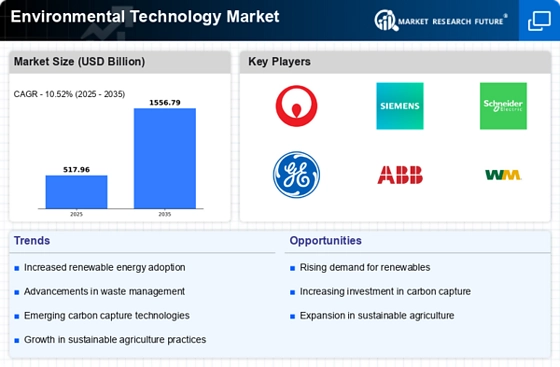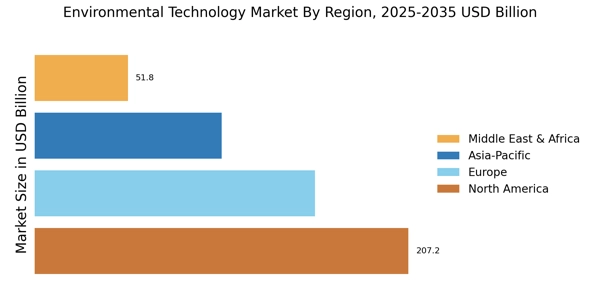Growing Public Awareness
Public awareness regarding environmental issues is on the rise, significantly impacting the Environmental Technology Market. As individuals become more informed about climate change, pollution, and resource depletion, there is a corresponding increase in demand for sustainable solutions. Surveys indicate that a substantial percentage of consumers are willing to pay a premium for eco-friendly products and services. This shift in consumer behavior is prompting businesses to adopt greener practices and invest in environmental technologies. Consequently, the Environmental Technology Market is poised for growth as companies strive to meet the evolving expectations of environmentally conscious consumers.
Technological Innovations
Technological advancements are playing a crucial role in shaping the Environmental Technology Market. Innovations in areas such as renewable energy, waste management, and water purification are driving efficiency and effectiveness in environmental solutions. For example, the development of advanced solar panels and energy storage systems has made renewable energy more accessible and cost-effective. Additionally, smart waste management technologies are optimizing resource recovery and minimizing landfill use. These innovations not only enhance the performance of environmental technologies but also contribute to the overall growth of the market, which is expected to reach a valuation of over 1 trillion dollars by 2030.
Increasing Regulatory Support
The Environmental Technology Market is experiencing a surge in regulatory support from various governments. This support is primarily aimed at promoting sustainable practices and reducing environmental degradation. For instance, many countries have implemented stringent regulations on emissions and waste management, which has led to an increased demand for innovative environmental technologies. The market is projected to grow at a compound annual growth rate (CAGR) of approximately 12% over the next five years, driven by these regulatory frameworks. As governments continue to prioritize environmental sustainability, the Environmental Technology Market is likely to benefit from enhanced funding and incentives for clean technology initiatives.
Corporate Sustainability Initiatives
The rise of corporate sustainability initiatives is significantly influencing the Environmental Technology Market. Many companies are adopting sustainability as a core component of their business strategies, driven by both regulatory pressures and consumer expectations. This trend is leading to increased investments in environmental technologies that enhance operational efficiency and reduce carbon footprints. Reports indicate that organizations implementing sustainable practices can achieve cost savings and improve their market competitiveness. As more businesses commit to sustainability, the Environmental Technology Market is expected to expand, driven by the demand for innovative solutions that align with corporate social responsibility goals.
Investment in Sustainable Infrastructure
Investment in sustainable infrastructure is a key driver of the Environmental Technology Market. Governments and private entities are increasingly recognizing the importance of building resilient and eco-friendly infrastructure. This includes the development of green buildings, sustainable transportation systems, and efficient waste management facilities. Such investments are not only aimed at reducing environmental impact but also at fostering economic growth. The Environmental Technology Market stands to benefit from these initiatives, as they create demand for innovative technologies that support sustainable development. As infrastructure projects continue to expand, the market is likely to see substantial growth opportunities.


















Leave a Comment